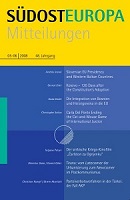Alliance-Building Strategies in Post-communist Romania (1990-2016)
Alliance-Building Strategies in Post-communist Romania (1990-2016)
Bonding through Dependence?
Author(s): Veronica AnghelSubject(s): Politics
Published by: Südosteuropa Gesellschaft e.V.
Keywords: Romania;political system;
Summary/Abstract: Romania is a semi-presidential republic with a multi-party parliamentary system. During the 28 years of democratic state-building, this institutional design has forced political parties tobuild electoral alliances and form coalition governments. The article illuminates the reasons foran alliance of the Romanian parties in their quest for winning votes in the post-communistsetting. It reflects on the most successful alliance-building models in the seven electoralcycles of parliament that have taken place between 1990 and 2016.Two alternating patterns for electoral success in Romania can be identified: (type 1) alliancesaround one managerially efficient dominating party (mostly the Social Democratic Party / PSD);and (type 2) negative single-issue based alliances (“the anti” political campaigns).This type of alliance-strategies was reinforced by the results of the latest parliamentary electionsin December 2016. It illustrated the success of the PSD and the subsequent governmentformation together with its satellite party, the Alliance of Liberals and Democrats / ALDE (type 1alliance). As for the near future, considering there is little difference on the supply side of partyalternatives, we have good reasons to expect a continuation of the political configurationsdiscussed. Type 2 strategies remain the best strategy for opposition parties to have a chancefor reaching executive power.
Journal: Südosteuropa Mitteilungen
- Issue Year: 2017
- Issue No: 03
- Page Range: 16-29
- Page Count: 14
- Language: English
- Content File-PDF

